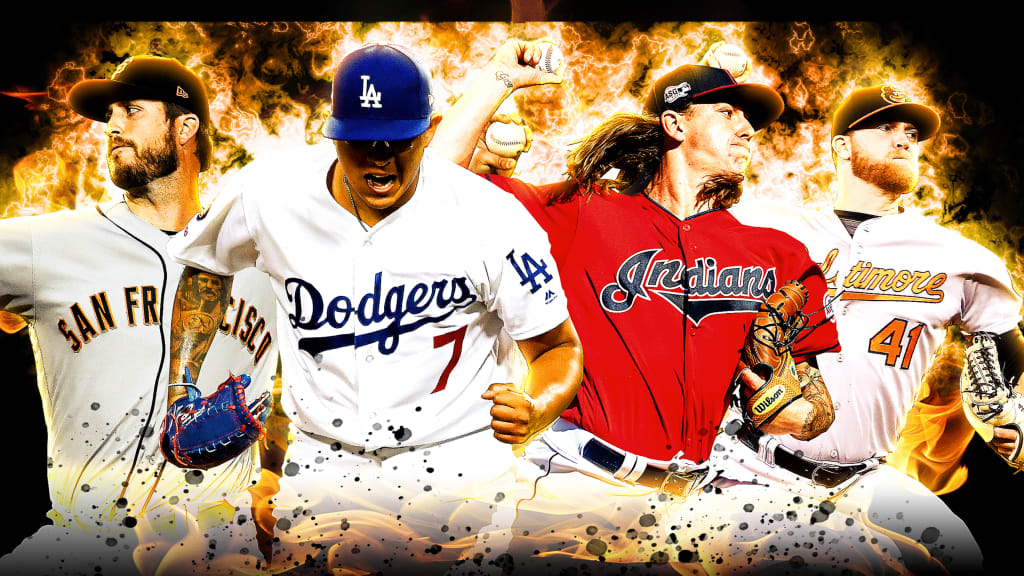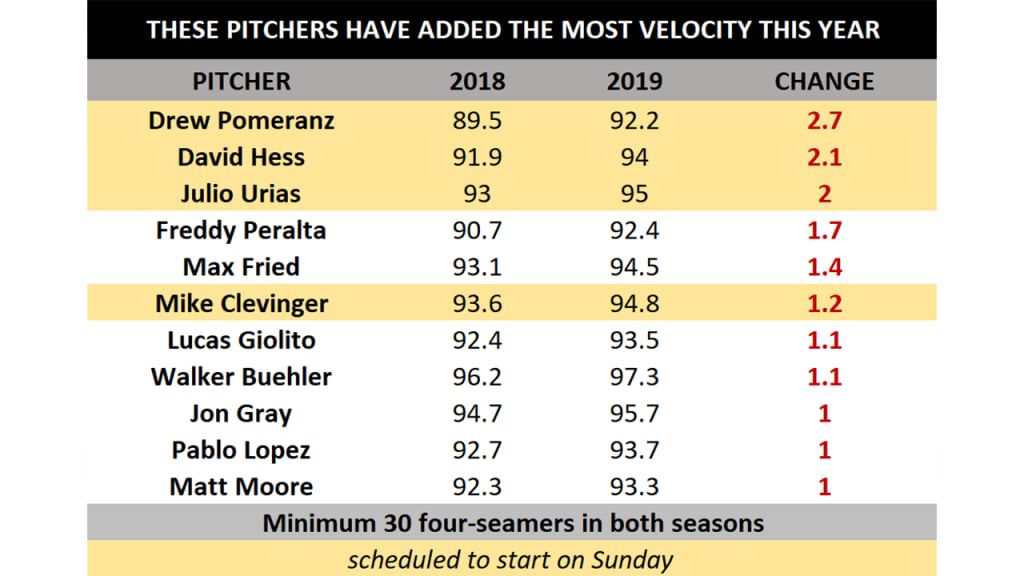
Early in the season, one of the first things you look at from a pitcher is his velocity. That's partially because numbers like ERA are just totally meaningless right now, and it's partially because velocity simply matters so much in today's game. Surely you've seen the increase in heat around the sport -- the average fastball in 2019 (93.5 mph) is nearly two miles per hour higher than 2008's 91.8 mph -- and surely you've seen the panic over the dramatic decline in Chris Sale's fastball numbers.
It's also because it's easy to measure in that you don't need more than a handful of pitches to know that Noah Syndergaard throws hard and Kyle Hendricks does not. And as this seminal 2010 study from current Braves analyst Mike Fast found, each additional mile per hour above 91 for starters can decrease runs allowed per game by about 0.2. It matters so, so much.
That being the case, it's fun to look at the early-season velocity numbers and see which starting pitchers have added four-seam fastball heat over what they did last year. Now, there are some obvious caveats here, namely that it probably takes about three starts to know if a pitcher's velocity change is "real," and that velocity often increases as the weather warms. Comparing a handful of pitches to a full season isn't exactly scientific.
But that's probably a larger issue for those who started off the year with lesser velocity, like how Reynaldo Lopez was down markedly in his first start and was back up to 96-97 on Friday. For those who are adding velocity, it's worth investigating why and whether it might be likely to stick -- and as it happens, four of the top six starters with added velocity are taking the mound today.

So: Can we find anything meaningful about these increases from today's starters? We can't guarantee they'll maintain, but we might be able to see something interesting.
Drew Pomeranz, Giants LHP: +2.7 MPH (89.5 to 92.2)
Sunday: vs. Rays, 4:05 p.m. ET
In so many cases, velocity -- or lack thereof -- is a sign of health, and in Pomeranz' case, it doesn't require a much detective work to see why he was only at 89.5 mph with the Red Sox last year. It's because he started the season late due to a forearm issue, then had biceps tendinitis and a neck issue.
In this case, it's not necessarily that his velocity is new, because he was often up around 91-92 in his best years with Oakland, San Diego and Boston. It's that his nightmare 2018 -- and that his 6.08 ERA -- seems to have been entirely about health. If he's sound, and his first start of 2019 gave hope he might be, then he could be a lot more like the solid starter who had a 3.24 ERA between 2014-17.
David Hess, Orioles RHP: +2.1 MPH (91.9 to 94)
Sunday: vs. Yankees, 1:05 p.m. ET
You probably know Hess for being pulled from a no-hitter in the seventh inning in Toronto last week, but he was never going to be allowed to go all the way anyway. More notable is how he got there, which was in part due to his additional velocity. He threw 103 1/3 innings in 2018, and touched 95 mph six times. On Monday, he threw 6 1/3 innings, and touched 95 mph ... seven times.
Hess was asked on local sports radio in Baltimore about where the heat came from.
"I think that's something that's always been there, but I think it's really just having the right access to things to tap into it is the best way to put it," Hess said. "Really, since day one, we've been working on a lot of stuff, just trying to refine a little. That's something that's always been there, I think it has been couple ticks up a little more these first couple outings. The analytics has been a little part of it, but I think more than anything, is just being able to go out there and be comfortable and relaxed."
That's not necessarily the most satisfying answer, really, though it's also about how he used it, raising the fastball from an average of 2.6 feet above home plate in 2018 to 2.9 feet in '19. The Yankees, however, make for a far more formidable opponent than the Blue Jays.
Julio Urias, Dodgers LHP: +2.0 MPH (93 to 95)
Sunday: vs. Rockies, 8:30 p.m. ET
It's hard to overstate how highly touted Urias was when he made his Major League debut at 19 years old in 2016, and how disappointing it was when he underwent left shoulder surgery the next season and missed nearly an entire year of play. He came back late last season and surprisingly made the Dodgers' postseason roster, but it wasn't until Monday that Urias made his first start in nearly two years.
It went well. Urias struck out seven Giants without a walk, with an average fastball velocity of 95 mph, after reports he was touching 97 mph during Spring Training. The Urias story is one that's entirely about health right now, because shoulder injuries are often much more difficult to return from than elbow injuries. If he truly is healthy, there's little reason to believe he can't keep up the heat.
Let's pause for a brief non-Sunday interlude...
Freddy Peralta, Brewers RHP: +1.7 MPH (90.7 to 92.4)
Max Fried, Braves LHP: +1.4 MPH (93.1 to 94.5)
Last year, we wrote about how Peralta used spin and deception to succeed despite "below-average velocity." In March, we heard about how his velocity had been trending up in Spring Training. On Wednesday, he struck out 11 Reds over eight scoreless innings. If this is real, it's incredibly important.
Fried's season debut featured the velocity bump you see above, and he actually touched 97.1 mph. Fried then took a perfect game into the sixth inning on Thursday against the Cubs. Velocity is good.
Back to Sunday...
Mike Clevinger, Indians RHP: +1.2 MPH (93.6 to 94.8)
Sunday: vs. Blue Jays, 1:10 p.m. ET
Remember: Clevinger was already very good. For all the attention given to Corey Kluber, Trevor Bauer, and Carlos Carrasco, Clevinger has put up a 3.05 ERA in 321 2/3 innings over the past two seasons.
Then, on Monday, he went out and struck out a career-high 12 hitters as Cleveland beat Chicago, 5-3. As MLB.com's Mandy Bell wrote, the added velocity wasn't an accident -- Clevinger had made extra heat a focus of his winter.
“It was a tick down today from what it has been through spring,” Clevinger said. “It’s something we’ve been working on this whole time, and I think even in my last outing of spring, I was averaging 96-something and today it was just under 95-something, so cold weather did play a little bit of a factor, but not much.”
So: What have we learned? Pomeranz and Urias may be getting healthy. Clevinger trained for exactly this purpose. It's a little harder to explain Hess. Velocity is generally good, and most of these guys have clear reasons for theirs. It's worth watching closely on Sunday.
